Xuanzhe Liu
MegaScale-Infer: Serving Mixture-of-Experts at Scale with Disaggregated Expert Parallelism
Apr 03, 2025Abstract:Mixture-of-Experts (MoE) showcases tremendous potential to scale large language models (LLMs) with enhanced performance and reduced computational complexity. However, its sparsely activated architecture shifts feed-forward networks (FFNs) from being compute-intensive to memory-intensive during inference, leading to substantially lower GPU utilization and increased operational costs. We present MegaScale-Infer, an efficient and cost-effective system for serving large-scale MoE models. MegaScale-Infer disaggregates attention and FFN modules within each model layer, enabling independent scaling, tailored parallelism strategies, and heterogeneous deployment for both modules. To fully exploit disaggregation in the presence of MoE's sparsity, MegaScale-Infer introduces ping-pong pipeline parallelism, which partitions a request batch into micro-batches and shuttles them between attention and FFNs for inference. Combined with distinct model parallelism for each module, MegaScale-Infer effectively hides communication overhead and maximizes GPU utilization. To adapt to disaggregated attention and FFN modules and minimize data transmission overhead (e.g., token dispatch), MegaScale-Infer provides a high-performance M2N communication library that eliminates unnecessary GPU-to-CPU data copies, group initialization overhead, and GPU synchronization. Experimental results indicate that MegaScale-Infer achieves up to 1.90x higher per-GPU throughput than state-of-the-art solutions.
Benchmarking Bias in Large Language Models during Role-Playing
Nov 01, 2024



Abstract:Large Language Models (LLMs) have become foundational in modern language-driven applications, profoundly influencing daily life. A critical technique in leveraging their potential is role-playing, where LLMs simulate diverse roles to enhance their real-world utility. However, while research has highlighted the presence of social biases in LLM outputs, it remains unclear whether and to what extent these biases emerge during role-playing scenarios. In this paper, we introduce BiasLens, a fairness testing framework designed to systematically expose biases in LLMs during role-playing. Our approach uses LLMs to generate 550 social roles across a comprehensive set of 11 demographic attributes, producing 33,000 role-specific questions targeting various forms of bias. These questions, spanning Yes/No, multiple-choice, and open-ended formats, are designed to prompt LLMs to adopt specific roles and respond accordingly. We employ a combination of rule-based and LLM-based strategies to identify biased responses, rigorously validated through human evaluation. Using the generated questions as the benchmark, we conduct extensive evaluations of six advanced LLMs released by OpenAI, Mistral AI, Meta, Alibaba, and DeepSeek. Our benchmark reveals 72,716 biased responses across the studied LLMs, with individual models yielding between 7,754 and 16,963 biased responses, underscoring the prevalence of bias in role-playing contexts. To support future research, we have publicly released the benchmark, along with all scripts and experimental results.
Empowering 1000 tokens/second on-device LLM prefilling with mllm-NPU
Jul 08, 2024



Abstract:On-device large language models (LLMs) are catalyzing novel mobile applications such as UI task automation and personalized email auto-reply, without giving away users' private data. However, on-device LLMs still suffer from unacceptably long inference latency, especially the time to first token (prefill stage) due to the need of long context for accurate, personalized content generation, as well as the lack of parallel computing capacity of mobile CPU/GPU. To enable practical on-device LLM, we present mllm-NPU, the first-of-its-kind LLM inference system that efficiently leverages on-device Neural Processing Unit (NPU) offloading. Essentially, mllm-NPU is an algorithm-system co-design that tackles a few semantic gaps between the LLM architecture and contemporary NPU design. Specifically, it re-constructs the prompt and model in three levels: (1) At prompt level, it divides variable-length prompts into multiple fixed-sized chunks while maintaining data dependencies; (2) At tensor level, it identifies and extracts significant outliers to run on the CPU/GPU in parallel with minimal overhead; (3) At block level, it schedules Transformer blocks in an out-of-order manner to the CPU/GPU and NPU based on their hardware affinity and sensitivity to accuracy. Compared to competitive baselines, mllm-NPU achieves 22.4x faster prefill speed and 30.7x energy savings on average, and up to 32.8x speedup in an end-to-end real-world application. For the first time, mllm-NPU achieves more than 1,000 tokens/sec prefilling for a billion-sized model (Qwen1.5-1.8B), paving the way towards practical on-device LLM.
RAGCache: Efficient Knowledge Caching for Retrieval-Augmented Generation
Apr 18, 2024Abstract:Retrieval-Augmented Generation (RAG) has shown significant improvements in various natural language processing tasks by integrating the strengths of large language models (LLMs) and external knowledge databases. However, RAG introduces long sequence generation and leads to high computation and memory costs. We propose Thoth, a novel multilevel dynamic caching system tailored for RAG. Our analysis benchmarks current RAG systems, pinpointing the performance bottleneck (i.e., long sequence due to knowledge injection) and optimization opportunities (i.e., caching knowledge's intermediate states). Based on these insights, we design Thoth, which organizes the intermediate states of retrieved knowledge in a knowledge tree and caches them in the GPU and host memory hierarchy. Thoth proposes a replacement policy that is aware of LLM inference characteristics and RAG retrieval patterns. It also dynamically overlaps the retrieval and inference steps to minimize the end-to-end latency. We implement Thoth and evaluate it on vLLM, a state-of-the-art LLM inference system and Faiss, a state-of-the-art vector database. The experimental results show that Thoth reduces the time to first token (TTFT) by up to 4x and improves the throughput by up to 2.1x compared to vLLM integrated with Faiss.
LoongServe: Efficiently Serving Long-context Large Language Models with Elastic Sequence Parallelism
Apr 15, 2024Abstract:The context window of large language models (LLMs) is rapidly increasing, leading to a huge variance in resource usage between different requests as well as between different phases of the same request. Restricted by static parallelism strategies, existing LLM serving systems cannot efficiently utilize the underlying resources to serve variable-length requests in different phases. To address this problem, we propose a new parallelism paradigm, elastic sequence parallelism (ESP), to elastically adapt to the variance between different requests and phases. Based on ESP, we design and build LoongServe, an LLM serving system that (1) improves computation efficiency by elastically adjusting the degree of parallelism in real-time, (2) improves communication efficiency by reducing key-value cache migration overhead and overlapping partial decoding communication with computation, and (3) improves GPU memory efficiency by reducing key-value cache fragmentation across instances. Our evaluation under diverse real-world datasets shows that LoongServe improves the maximum throughput by up to 3.85$\times$ compared to the chunked prefill and 5.81$\times$ compared to the prefill-decoding disaggregation.
Exploring the Impact of In-Browser Deep Learning Inference on Quality of User Experience and Performance
Feb 08, 2024


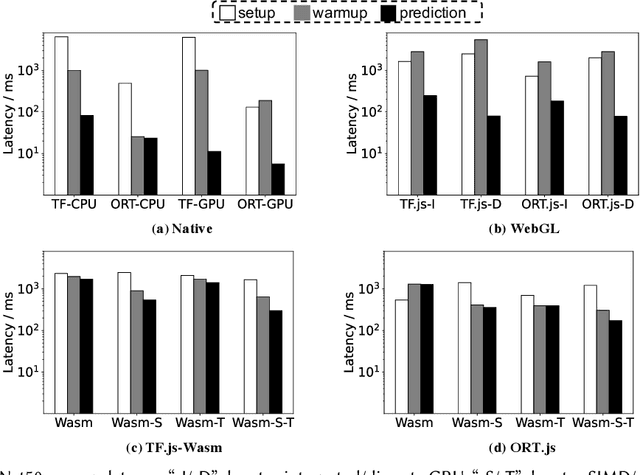
Abstract:Deep Learning (DL) is increasingly being integrated into Web applications through a method known as "in-browser inference", where the DL processes occur directly within Web browsers. However, the actual performance of this method and its effect on user experience quality (QoE) is not well-understood. This gap in knowledge necessitates new forms of QoE measurement, going beyond traditional metrics such as page load time. To address this, we conducted the first extensive performance evaluation of in-browser inference. We introduced new metrics for this purpose: responsiveness, smoothness, and inference accuracy. Our thorough study included 9 widely-used DL models and tested them across 50 popular PC Web browsers. The findings show a significant latency issue with in-browser inference: it's on average 16.9 times slower on CPU and 4.9 times slower on GPU than native inference methods. Several factors contribute to this latency, including underused hardware instruction sets, inherent delays in the runtime environment, resource competition within the browser, and inefficiencies in software libraries and GPU abstractions. Moreover, in-browser inference demands a lot of memory, sometimes up to 334.6 times more than the size of the DL models themselves. This excessive memory usage is partly due to suboptimal memory management. Additionally, we noticed that in-browser inference increases the time it takes for graphical user interface (GUI) components to load in web browsers by a significant 67.2\%, which severely impacts the overall QoE for users of web applications that depend on this technology.
A Survey of Resource-efficient LLM and Multimodal Foundation Models
Jan 16, 2024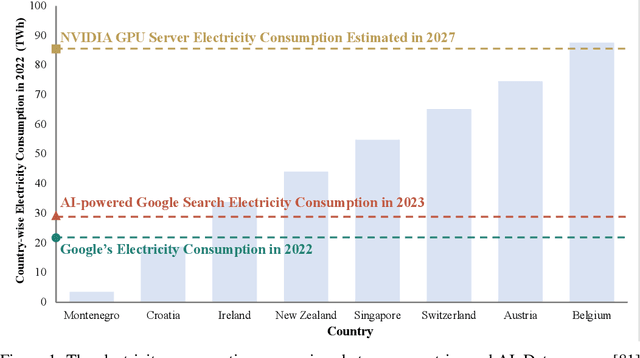
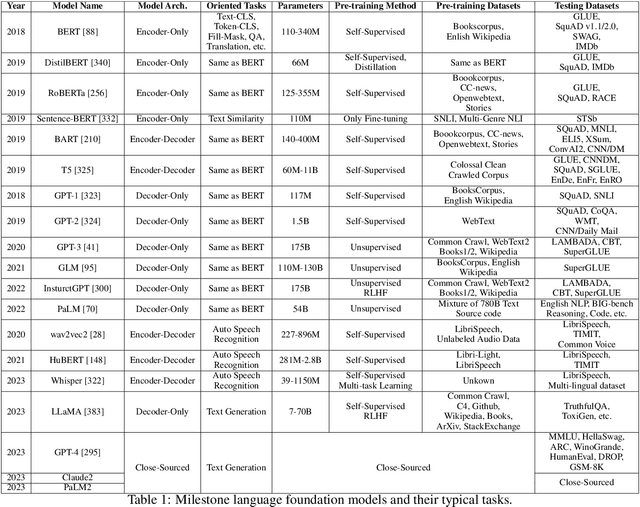
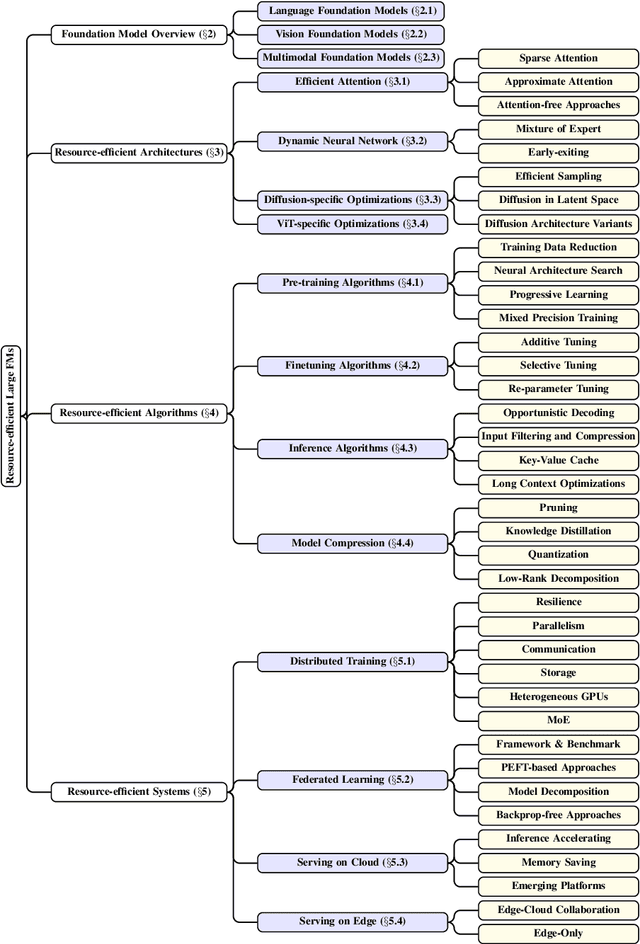
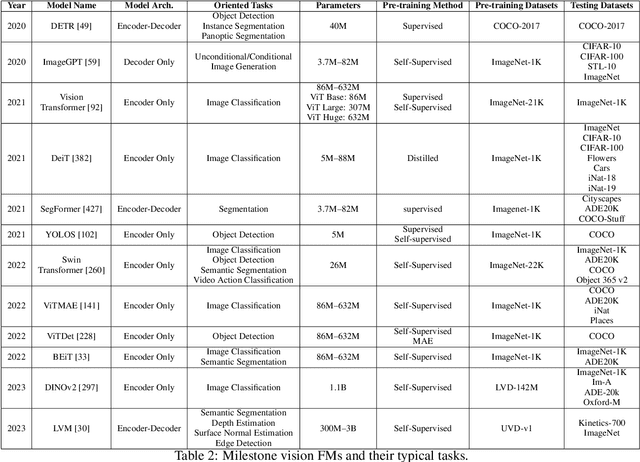
Abstract:Large foundation models, including large language models (LLMs), vision transformers (ViTs), diffusion, and LLM-based multimodal models, are revolutionizing the entire machine learning lifecycle, from training to deployment. However, the substantial advancements in versatility and performance these models offer come at a significant cost in terms of hardware resources. To support the growth of these large models in a scalable and environmentally sustainable way, there has been a considerable focus on developing resource-efficient strategies. This survey delves into the critical importance of such research, examining both algorithmic and systemic aspects. It offers a comprehensive analysis and valuable insights gleaned from existing literature, encompassing a broad array of topics from cutting-edge model architectures and training/serving algorithms to practical system designs and implementations. The goal of this survey is to provide an overarching understanding of how current approaches are tackling the resource challenges posed by large foundation models and to potentially inspire future breakthroughs in this field.
LLMCad: Fast and Scalable On-device Large Language Model Inference
Sep 08, 2023Abstract:Generative tasks, such as text generation and question answering, hold a crucial position in the realm of mobile applications. Due to their sensitivity to privacy concerns, there is a growing demand for their execution directly on mobile devices. Currently, the execution of these generative tasks heavily depends on Large Language Models (LLMs). Nevertheless, the limited memory capacity of these devices presents a formidable challenge to the scalability of such models. In our research, we introduce LLMCad, an innovative on-device inference engine specifically designed for efficient generative Natural Language Processing (NLP) tasks. The core idea behind LLMCad revolves around model collaboration: a compact LLM, residing in memory, takes charge of generating the most straightforward tokens, while a high-precision LLM steps in to validate these tokens and rectify any identified errors. LLMCad incorporates three novel techniques: (1) Instead of generating candidate tokens in a sequential manner, LLMCad employs the smaller LLM to construct a token tree, encompassing a wider range of plausible token pathways. Subsequently, the larger LLM can efficiently validate all of these pathways simultaneously. (2) It employs a self-adjusting fallback strategy, swiftly initiating the verification process whenever the smaller LLM generates an erroneous token. (3) To ensure a continuous flow of token generation, LLMCad speculatively generates tokens during the verification process by implementing a compute-IO pipeline. Through an extensive series of experiments, LLMCad showcases an impressive token generation speed, achieving rates up to 9.3x faster than existing inference engines.
Dark-Skin Individuals Are at More Risk on the Street: Unmasking Fairness Issues of Autonomous Driving Systems
Aug 05, 2023Abstract:This paper conducts fairness testing on automated pedestrian detection, a crucial but under-explored issue in autonomous driving systems. We evaluate eight widely-studied pedestrian detectors across demographic groups on large-scale real-world datasets. To enable thorough fairness testing, we provide extensive annotations for the datasets, resulting in 8,311 images with 16,070 gender labels, 20,115 age labels, and 3,513 skin tone labels. Our findings reveal significant fairness issues related to age and skin tone. The detection accuracy for adults is 19.67% higher compared to children, and there is a 7.52% accuracy disparity between light-skin and dark-skin individuals. Gender, however, shows only a 1.1% difference in detection accuracy. Additionally, we investigate common scenarios explored in the literature on autonomous driving testing, and find that the bias towards dark-skin pedestrians increases significantly under scenarios of low contrast and low brightness. We publicly release the code, data, and results to support future research on fairness in autonomous driving.
Fast Distributed Inference Serving for Large Language Models
May 10, 2023Abstract:Large language models (LLMs) power a new generation of interactive AI applications exemplified by ChatGPT. The interactive nature of these applications demand low job completion time (JCT) for model inference. Existing LLM serving systems use run-to-completion processing for inference jobs, which suffers from head-of-line blocking and long JCT. We present FastServe, a distributed inference serving system for LLMs. FastServe exploits the autoregressive pattern of LLM inference to enable preemption at the granularity of each output token. FastServe uses preemptive scheduling to minimize JCT with a novel skip-join Multi-Level Feedback Queue scheduler. Based on the new semi information-agnostic setting of LLM inference, the scheduler leverages the input length information to assign an appropriate initial queue for each arrival job to join. The higher priority queues than the joined queue are skipped to reduce demotions. We design an efficient GPU memory management mechanism that proactively offloads and uploads intermediate states between GPU memory and host memory for LLM inference. We build a system prototype of FastServe based on NVIDIA FasterTransformer. Experimental results show that compared to the state-of-the-art solution Orca, FastServe improves the average and tail JCT by up to 5.1$\times$ and 6.4$\times$, respectively.
 Add to Chrome
Add to Chrome Add to Firefox
Add to Firefox Add to Edge
Add to Edge